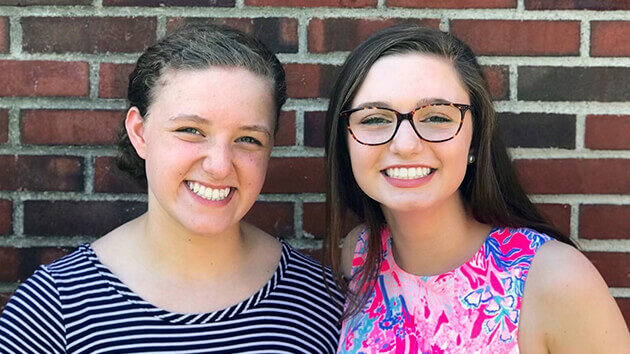Bethlehem Sisters Can Breathe Easier Thanks to Albany Med Guidance, Expertise

Just breathe. For two teenage sisters from Bethlehem diagnosed with an increasingly prevalent respiratory condition often confused with asthma, the instinctive act of breathing – and doing it correctly -- required the keen insights and guidance of trained Albany Med experts.
Anna Bernasconi, 19, and her sister Sarah, 16, share a bond that extends beyond their competitive swimming backgrounds. Both teens started experiencing minor respiratory issues in and around the pool during their adolescent years. Anna’s pediatrician prescribed a rescue inhaler for exercise-induced asthma in her early teens; Sarah first started experiencing troubled breathing in sixth grade. Both dismissed their symptoms as a commonly accepted part of their sport.
The first indication of a more severe condition surfaced for Anna during an intense swimming practice in fall 2018. Suddenly finding herself gasping for air between strokes, she described the uncomfortable sensation “like something was stuck, like there was almost a rock in my throat.” She quickly exited the pool as her coach rushed her outside for air. She was taken to the Massry Family Children’s Emergency Center and later followed up with Albany Med physicians.
Pediatric pulmonologist Robert Kaslovsky, MD, diagnosed her with vocal cord dysfunction (VCD), which he describes as “an involuntary closure of vocal cords that makes it difficult for a person to inhale.” He said it’s not wheezing and it’s not asthma. “VCD can occur at any age, although it’s more common among teenagers,” he said.
Daniel Kayajian, MS, CCC-SLP, a speech pathologist in the Department of Otolaryngology affectionately known as “Dr. Dan” to his patients, confirmed the diagnosis by examining Anna’s vocal folds via a scope gently inserted through her nose. Kayajian theorizes that VCD is often a byproduct of maladaptive breathing where patients over-engage their neck and shoulder muscles rather than their lower abdomen. To correct these bad habits, he works with patients on diaphragmatic breathing, shows them how to relax throat muscles and teaches rescue or recovery breathing techniques. Finally, he instructs them on visualization when performing their breathing exercises to master their breathing techniques.
Anna recalls her sense of relief after finally having a firm diagnosis. “Just knowing that there was a plan of action really put me at ease,” she said.
Sarah, diagnosed in 2020, now often compares breathing techniques with her older sibling. “Having the tools that Dr. Dan gave me I feel that I improved my situation greatly,” said Sarah, a dancer who also enjoys singing at church and her school choir. “The biggest thing for me was making it habitual.”
Equipped with the proper tools and insights from Albany Med, the two sisters and their parents now all breathe much easier.